The managerial merry-go-round is still active in Belgian football with another domino falling last weekend as KAS Eupen announced the appointment of former Werder Bremen and Wolfsburg boss Florian Kohfeldt to replace Edward Still, who departed the Belgian club at the end of this past season after losing to Club Brugge 7-0 on the final day and just barely avoiding relegation.
Kohfeldt had a rather successful spell in charge of Werder Bremen, while also managing in the UEFA Champions League with Wolfsburg.
This tactical analysis and scout report will take a look at the 40-year-old German’s tactics at his last two managerial stops, as well as what Eupen fans can expect to see from their side at the start of the 2023/24 Belgian Pro League season.
Preferred formations and style of play
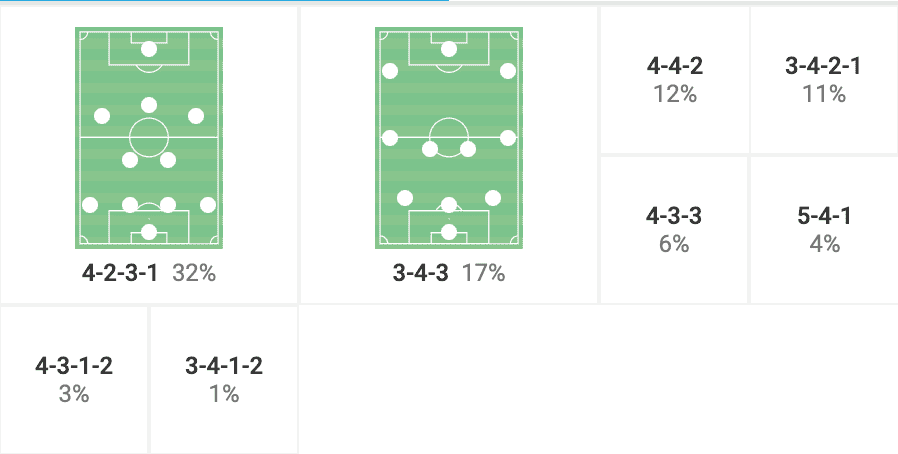
The image above shows the formations that were used during Wolfsburg’s 2021/22 season.
Kohfeldt did not take over until the end of October in 2021, with former Bayern Munich and Barcelona striker and current Royal Antwerp manager Mark van Bommel in charge at the start of the season.
The Dutchman preferred to set up Wolfsburg in a 4-2-3-1, with Kohfeldt instead preferring a back three system, normally alternating between a 3-4-3 or a 3-4-2-1.
At Werder Bremen, Kohfeldt’s side did not often hold much possession in a match, with them looking to instead attack opposition sides in transitional moments.
When he was at Wolfsburg, with an arguably more talented squad, he was able to play a bit more possession football, with them looking to hold the majority of possession in some matches.
However, the 40-year-old German is a manager who likes to set his side up based on the opposition and how they play, with some of his tactics changing from match to match.
Heavy emphasis on wing-backs and wide midfielders in attack
When watching how Florian Kohfeldt’s sides attack, it is easy to spot the emphasis that the German manager places on both his wing-backs and wide midfielders to be involved in creating chances in the final third.
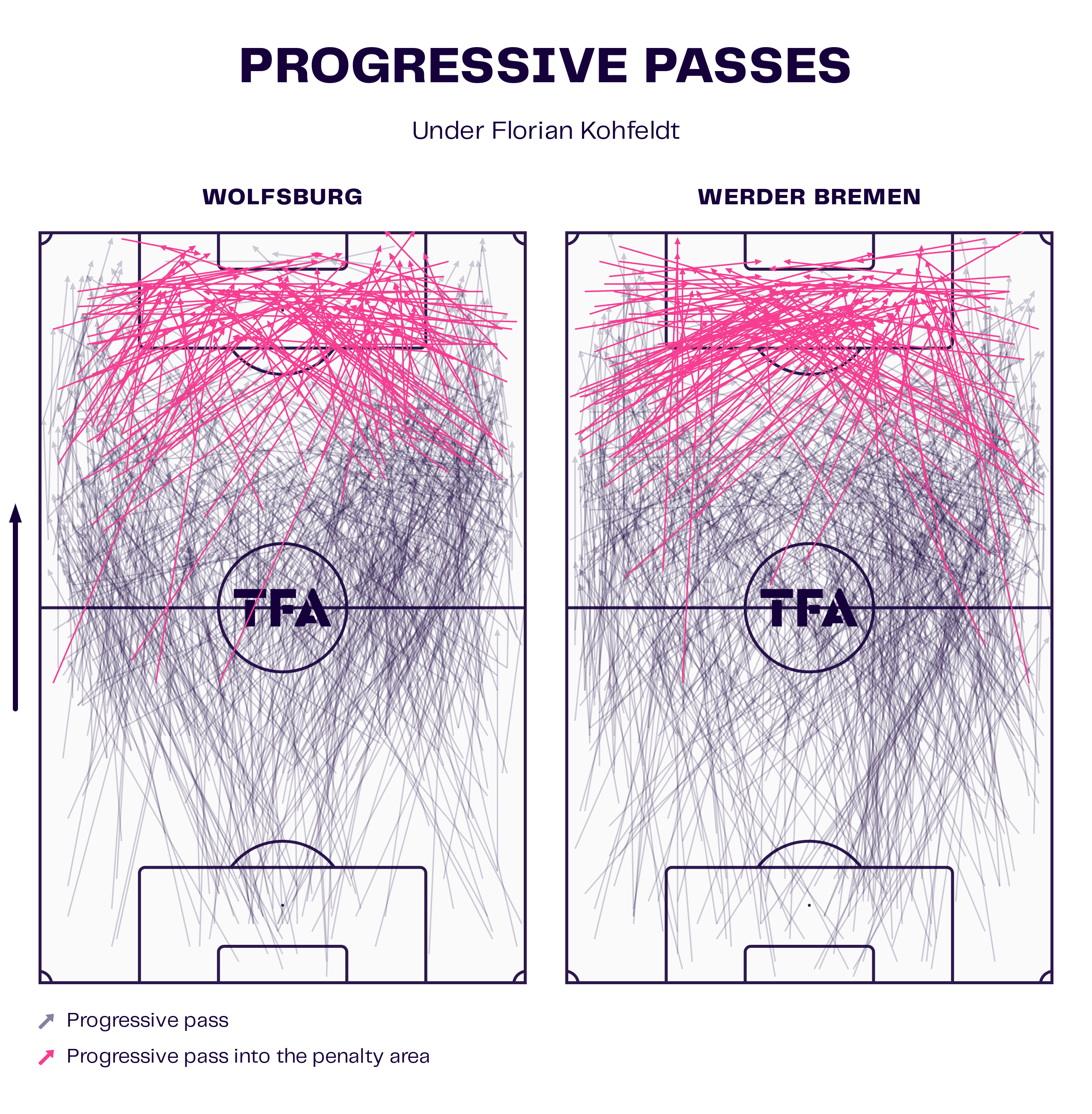
The data viz graphic above highlights the progressive passes played by both Wolfsburg under Kohfeldt, and Werder Bremen in the German’s last season in charge, the 2020/21 campaign.
What is illustrated by these graphics is the number of progressive passes into the penalty area that came from the wide areas of the pitch.
This shows the emphasis of both the wing-backs and the wide midfielders in getting forward to create chances, as well as their abilities to create potential overloads on the flanks to progress the ball behind opposition defensive lines.
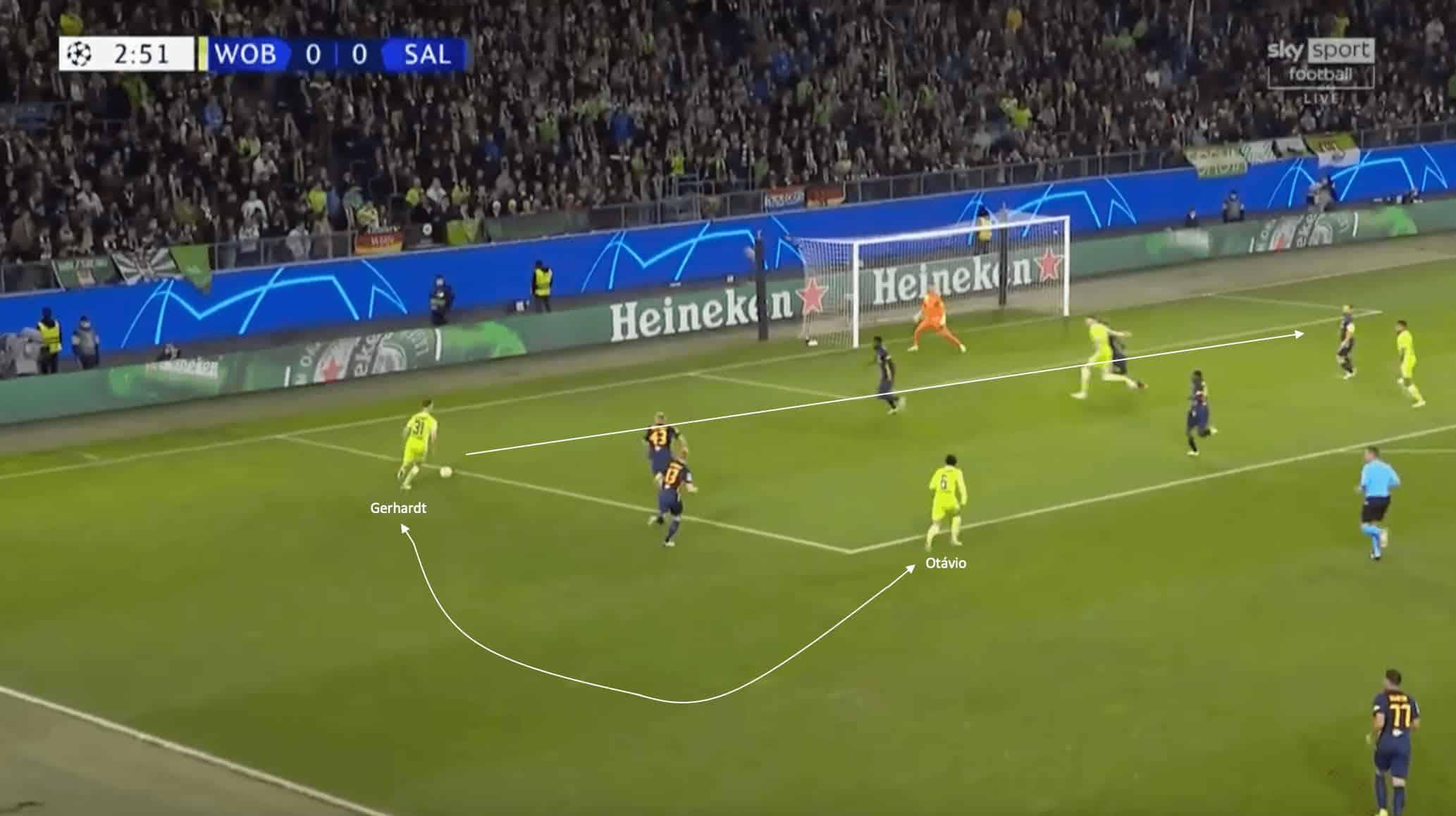
The image above shows an example of Kohfeldt’s wide players being the key contributors for this Wolfsburg goal against RB Salzburg in the UEFA Champions League.
In the phase of play above, the attacking move started with the wing-back Paulo Otávio, who drove forward in possession to get the Salzburg defenders to step out.
He was then able to play the ball forward to Yannick Gerhardt, who was playing as the left-sided wide forward.
After receiving possession and driving forward to just inside the penalty box, the German attacker played a great ball across the box, with it being fired home at the back post by opposite wing-back Ridle Baku.
This type of goal is a frequent trend under Kohfeldt, with the wing-backs scoring relatively often from these late runs into the box onto the end of a ball played from the opposite flank.
In fact, during the 2021/22 season when Florian Kohfeldt was in charge of Wolfsburg, Ridle Baku finished with 5 goals in all competitions, the joint third-highest goalscorer for the Bundesliga side.
This also occurred during Kohfeldt’s last season with Werder Bremen, the 2020/21 Bundesliga season, with wing-back Theodor Gebre Selassie scoring 4 goals, the fourth-highest total for the Bundesliga side.
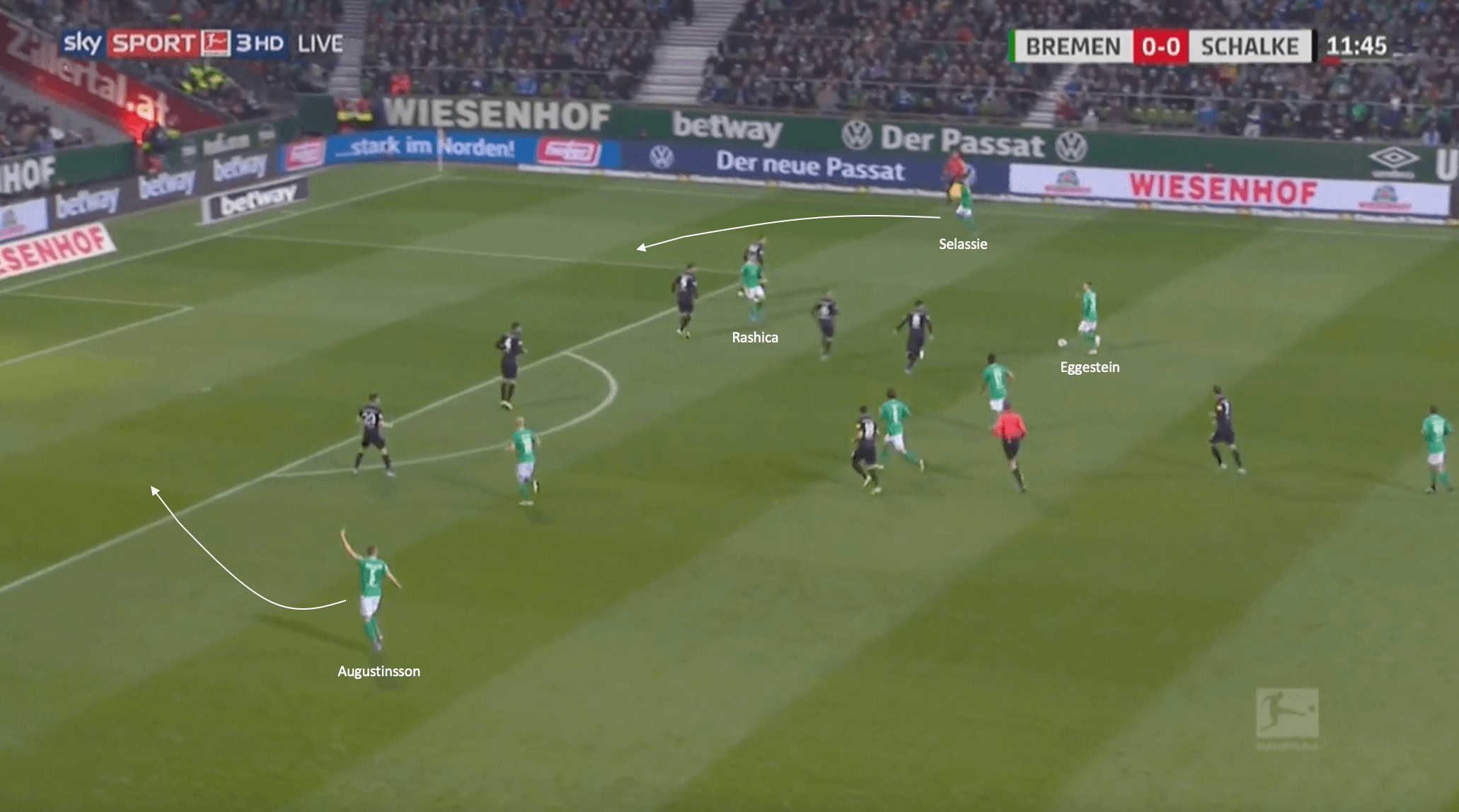
The image above shows another example of the emphasis placed by Kohfeldt on the wing-backs being able to get forward and be key contributors in the attacking phases of play.
In this phase of play above from his time managing Werder Bremen, we can see how the two wing-backs, Ludwig Augustinsson and Theodor Gebre Selassie, are well advanced and are keeping the width for Bremen.
The wide forwards stay more tucked in and narrow, as shown by the positioning of Kosovan Milot Rashica.
With Maximillian Eggestein driving forward in possession, it creates an overload down that far side for Werder Bremen, but the current Freiburg midfielder chooses the wrong option, with him attempting to play the ball to the heavily marked Rashica.
Though this example does not result in either wing back receiving the ball, it still highlights the emphasis Kohfeldt places on them from an attacking perspective.
Also, with the wide forwards tucking inside and looking to overload the central areas with the central striker and advancing central midfielders, it keeps the opposition’s defence narrow.
This allows the space out wide for the wing-backs to advance, allowing them to be dangerous in these attacking moments.
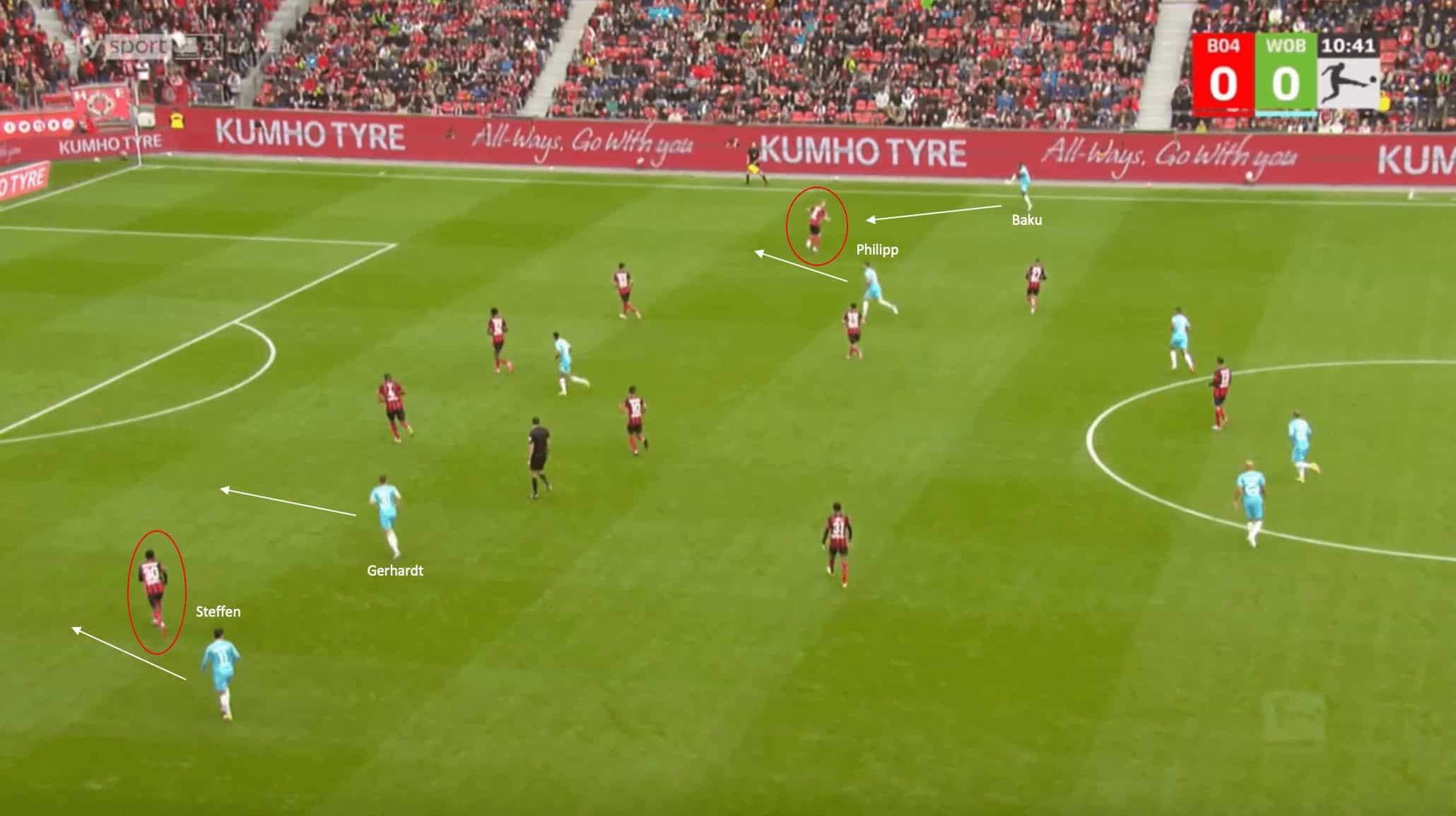
The image above shows another example of Kohfeldt’s style of attacking play leading to overloads down the flanks that are able to be exploited.
In this phase of play above against Bayer Leverkusen, we can see how both wing-backs have moved into advanced areas, with the wide forwards tucking inside to support.
With the central defenders of Leverkusen narrow, this leaves the outside backs isolated 2v1 on both flanks, allowing Wolfsburg to essentially create two overloads.
The ball is in possession of Baku, who plays the pass to former Borussia Dortmund player Maximillian Philipp, who makes an underlapping run past the outside back and into the space behind the backline.
This allows Wolfsburg to progress the ball into a dangerous area and look to create a goal-scoring chance.
As this section has shown, Florian Kohfeldt’s attacking tactics and principles place a heavy emphasis on the wing-backs, who when working in unison with the wide forwards, are able to create overloads in the wide areas as well as be key contributors going forward when it comes to chance creation in the final third.
Defensive principles
Being that Florian Kohfeldt opts for his sides to start in a back three formation, when they turn over possession, they often transition into a back five shape.
Like most managers in German football, Kohfeldt also employs his sides to counter-press when they lose possession, but they will sit back as well if they can not regain possession in the opponent’s half.
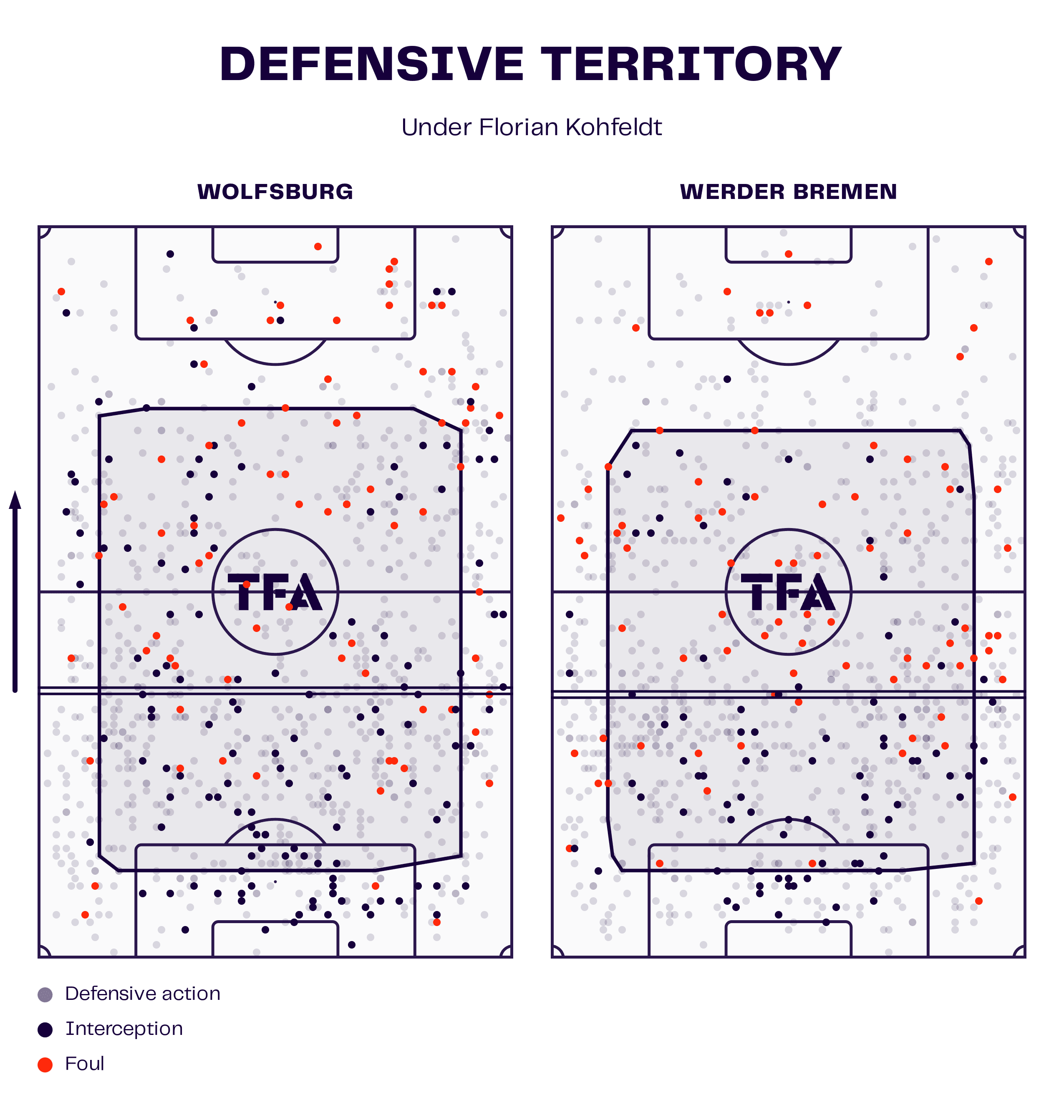
The data viz graphic above shows the defensive territory of both Wolfsburg under Florian Kohfeldt, as well as the 40-year-old’s final season at Werder Bremen.
At both stops, Kohfeldt had his defensive line sit rather deep, with them looking to drop off into a narrow and compact shape if they were unsuccessful in counter-pressing.
There is also a similar average line of defensive engagement from his time at both clubs, with that being about halfway inside their own defensive half, highlighting Kohfeldt’s tendency to have his sides drop off defensively if they are unsuccessful in regaining possession.
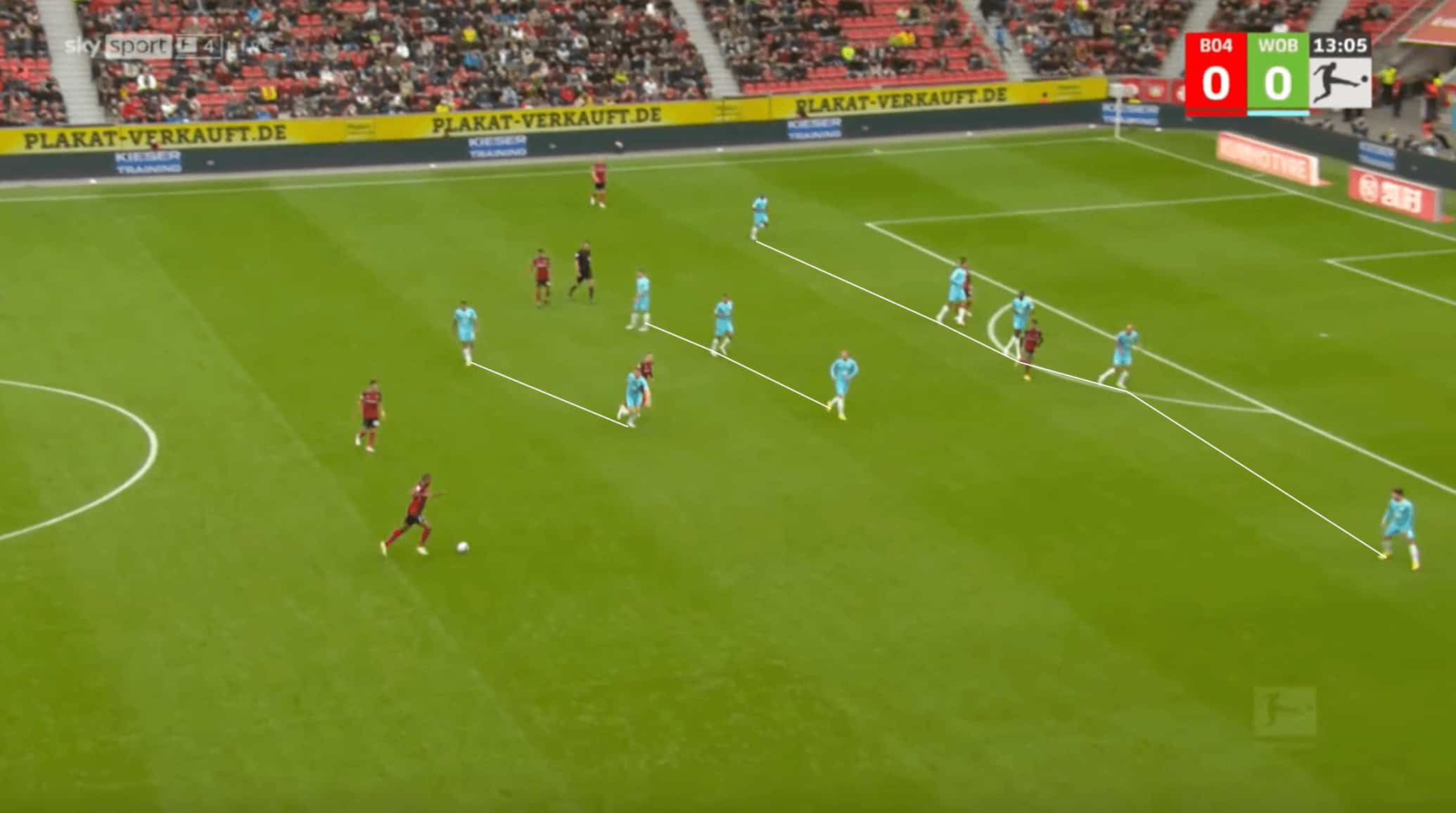
The image above shows an example of a defensive phase from Kohfeldt’s time at Wolfsburg.
In the phase of play above, Bayer Leverkusen have managed to progress the ball into the Wolfsburg half of the pitch, with Kohfeldt’s side dropping off and setting up in a compact 5-3-2 shape.
The two strikers are positioned around where the average line of defensive engagement for Wolfsburg was during the 40-year old’s time in charge.
From a defensive standpoint, Kohfeldt looks for his wing-backs to be slightly more stretched, which allows them to be 1v1 against opposition wingers while still having a numerical advantage centrally with the three centre-backs playing more narrow.
Leverkusen are able to shift the ball out wide to the winger on the near sideline.
This is exactly what Kohfeldt wants, with the rest of the defence able to stay compact and drop into the penalty box to defend against an incoming cross while the wing-back engages the wide player.
Due to their superior numerical advantage, when the cross is played in from the winger, Wolfsburg are able to clear the danger.
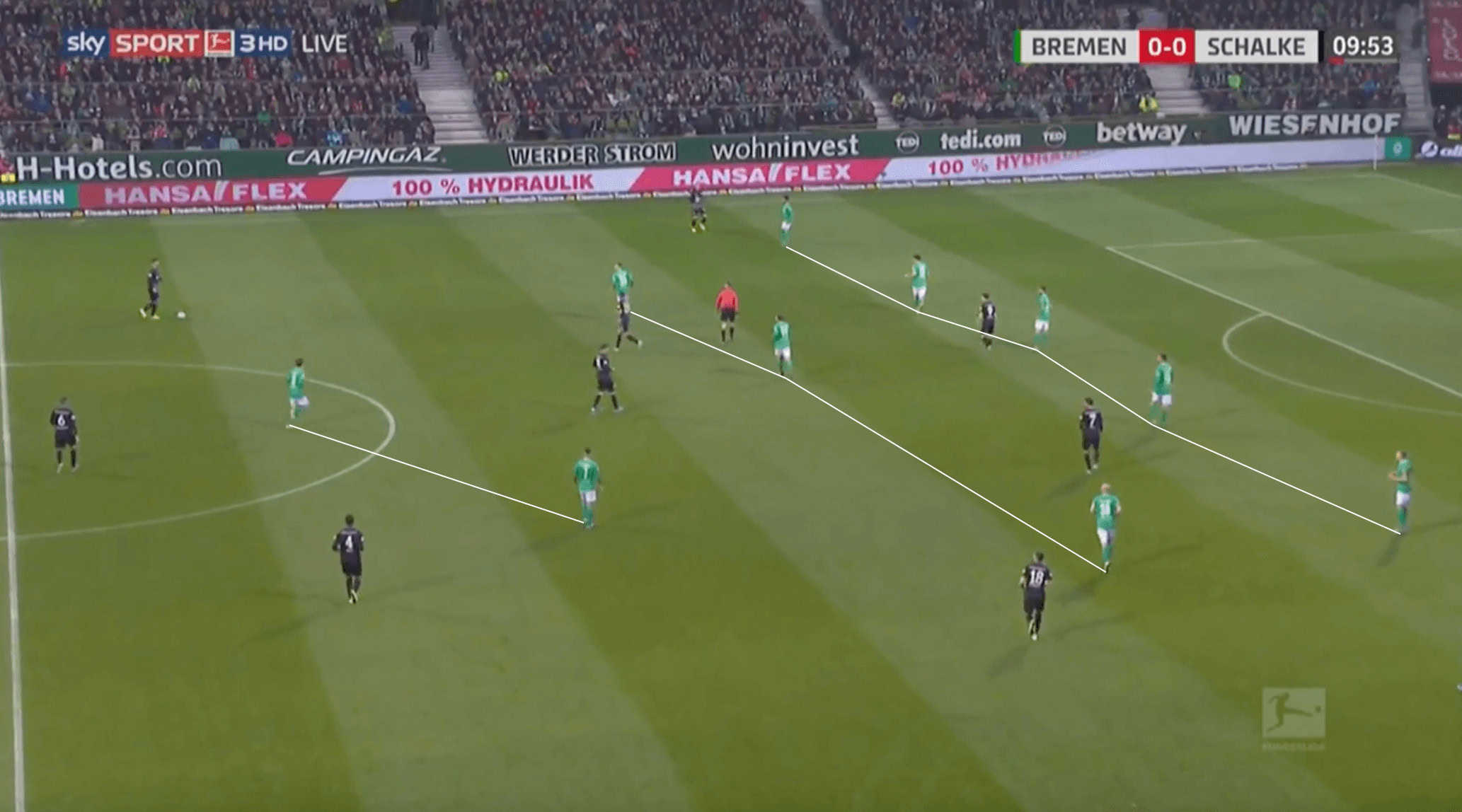
The image above shows another defensive phase from Florian Kohfeldt’s side, this time from his spell at Werder Bremen.
As we can see, the same 5-3-2 shape is present, but not as compact due to where the opposition are in possession.
However, the back five are again similarly positioned like the previous example.
The three centre-backs are playing much narrower, with them having a numerical advantage against the two Schalke strikers, making it difficult for the ball to be played into the feet of the forwards.
The wing-backs are positioned slightly wider, operating in essential 1v1s against the two opposition wide players.
Again, Kohfeldt wants the opposition to play into these wide areas, as it would allow them a numerical advantage in the central areas if the ball were to be served in from the wide areas with the wing-backs being isolated against the opposition wingers or wide midfielders.
Looking to counter-press in the opposition’s half
When watching a side managed by Florian Kohfeldt, you will notice pressing, but most of the time it is from counter-pressing situations.
Counter-pressing, or gegenpressing, is a very common tactical principle in German football.
While Kohfeldt does not counter-press as often or as aggressively as a Jürgen Klopp side, he still does utilise this tactical principle.
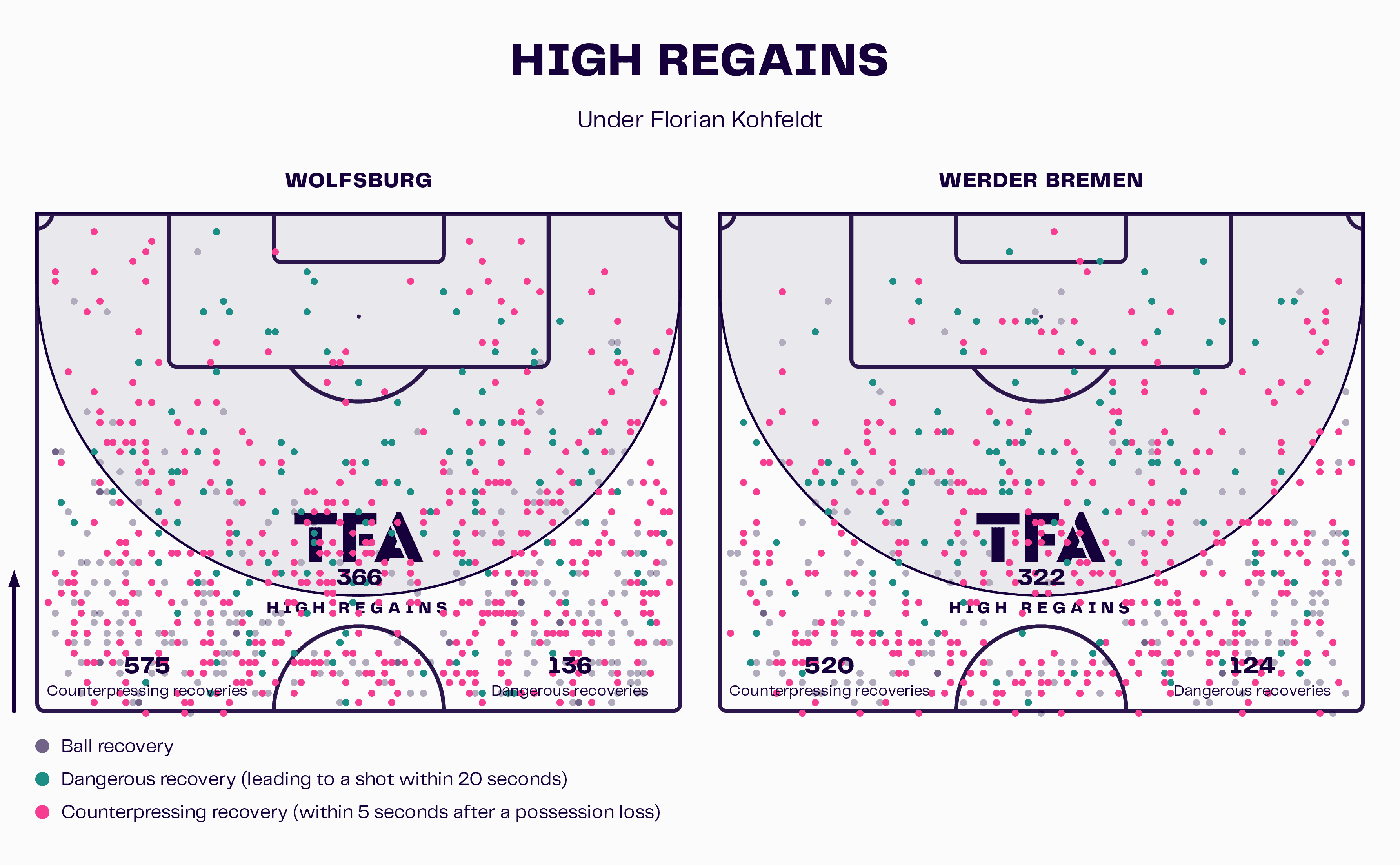
The data viz graphic above shows the high regains chart from Kohfeldt’s time at both Wolfsburg and Werder Bremen.
The main number that stands out from his time at both clubs is the number of counter-pressing recoveries his side had.
For his just under one season in charge of Wolfsburg, the German side had 575 counter-pressing recoveries, whereas, in the 2020/21 Bundesliga season in charge of Werder Bremen, his side had 520 counter-pressing recoveries.
During his time with Wolfsburg, Kohfeldt’s side actually had one of the highest number of counter pressing recoveries in the Bundesliga, showing the tendency at which his sides look to regain possession quickly after losing it.
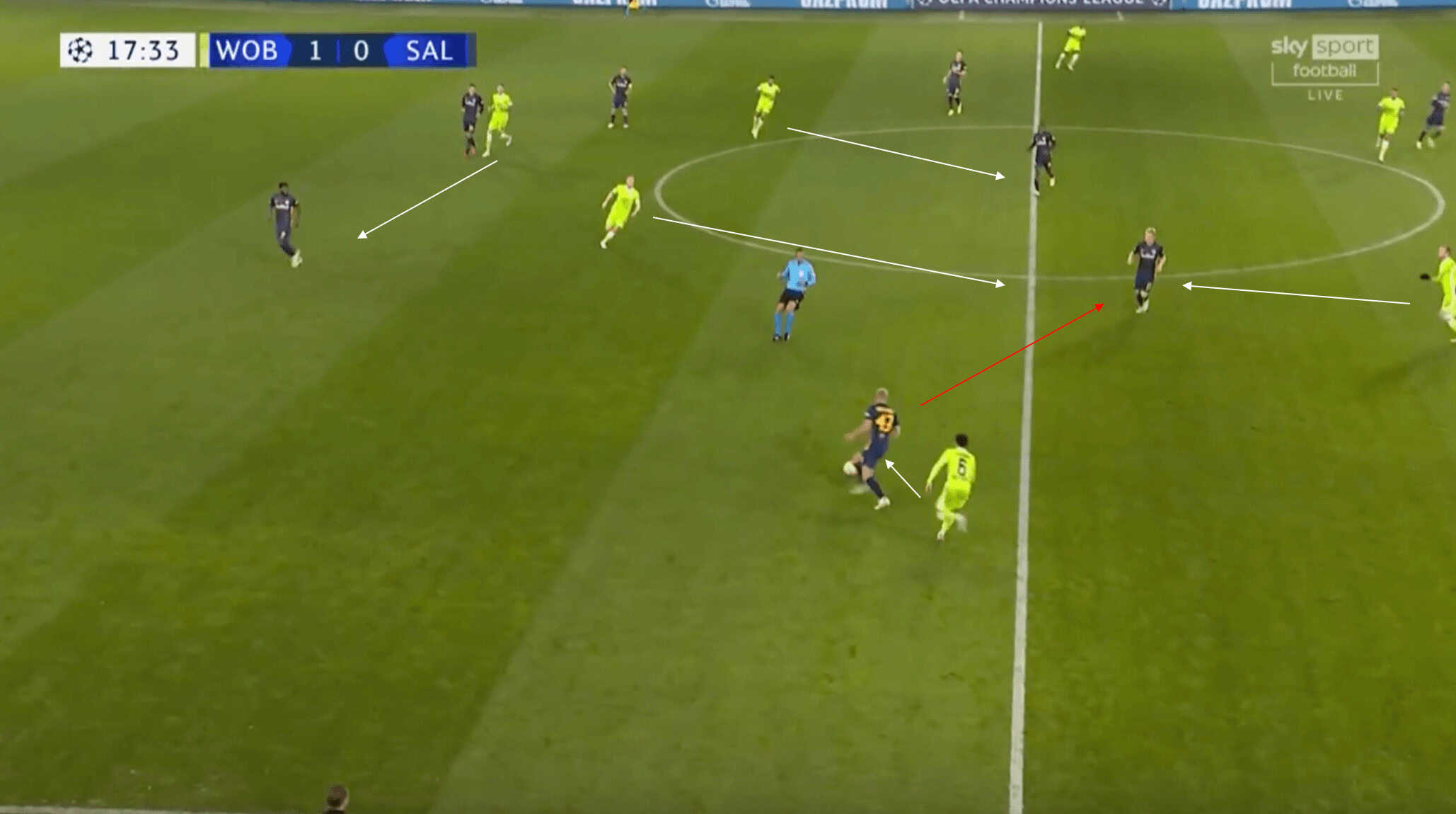
The image above shows a counter-pressing phase from Wolfsburg under Florian Kohfeldt.
The German side turned possession over near midfield, with the wing-back Paulo Otávio being dispossessed.
This activates the counter-pressing sequence from Wolfsburg, with Otávio looking to keep the pressure on the Salzburg player as he dribbles towards his own goal.
The rest of the surrounding Wolfsburg players look to collapse on the closest opposition players, with their goal being to quickly regain possession within a three to five-second window.
Unfortunately, Salzburg are able to play out of the counter-press and switch the play to the opposite flank.
However, what is key is that Wolfsburg do not commit too many numbers forward to this counter-press, which allows them to get into their defensive shape quickly and not be exposed defensively.
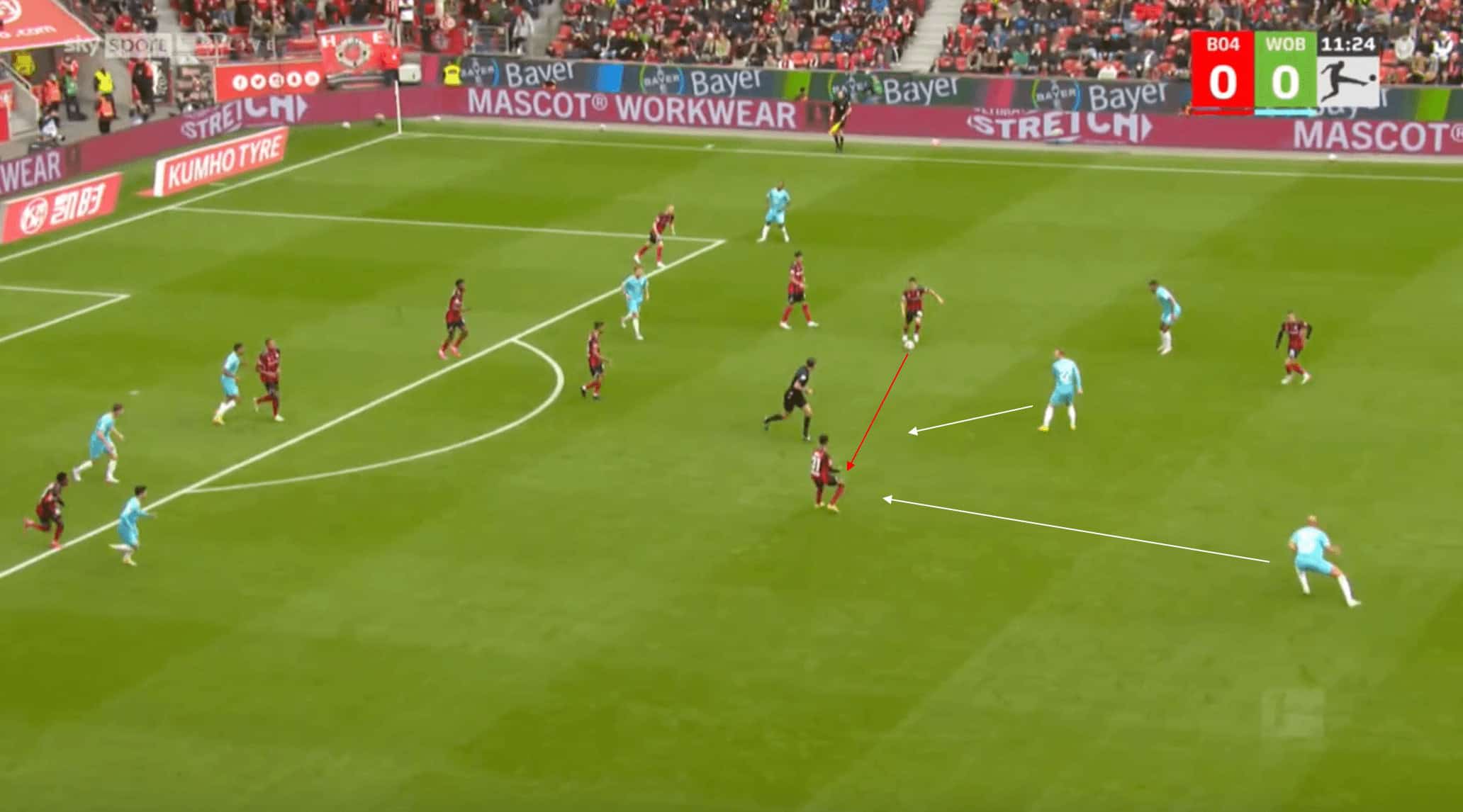
The image above shows another example of the counter-pressing of Florian Kohfeldt’s side leading to Wolfsburg regaining possession in an advanced area.
Preceding this image, Wolfsburg had just lost possession on the edge of the Leverkusen penalty box, with this pass that is being played the second one after possession was turned over.
The ball is played sideways by Leverkusen, with central defender John Brooks stepping up to counter-press and to win the ball back, with it falling to the closest positioned Wolfsburg midfielder.
The ensuing attacking move from Wolfsburg results in a corner, with a goal-scoring opportunity arising from this counter-pressing phase of play.
As this section has shown, while he does look for his sides to counter press, it is not a gung ho pressing style that results in gaps being left behind his defence.
If the ball is not won back within a few seconds, Kohfeldt asks his side to drop off and get into their defensive shape, with them not often looking to commit too many numbers forward to pressing moments, as it allows most of the side to stay back and quickly get into their defensive shape if the opposition are able to get through the counter-press.
Conclusion
In Florian Kohfeldt, KAS Eupen are getting a very talented young manager, as this tactical analysis has shown, one that should be able to get a tune out of the squad that he will have at his disposal.
With Eupen barely surviving in the top tier of Belgian football last season, the 40-year-old German tactician will have to show that he is the man that can drag the Belgian side back up the table next season.





Comments